Spreadsheets and manual data entry might help you manage inventory in Magento when you’re starting out. But you’ll eventually realize that they aren’t enough to keep up with the demands of omnichannel retail.
A 2022 report by Shopify reveals that 53% of brands are investing in tools that enable multichannel retail. So if you’re looking to grow your online business, investing in an inventory management tool for Magento is the way to go.
Don’t know where to start?
Read our guide to understand how Magento inventory management works and which tools can help you improve Magento’s inventory management features.
Here’s what we cover:
- Magento Inventory Management: A High-Level Overview
- Top 6 Magento Inventory Management Tools
- Final Thoughts: A Guide to Magento Inventory Management
Magento Inventory Management: A High-Level Overview
The inventory management module for Magento installs by default in Magento versions 2.3.x and above. It introduces Multi-Source Inventory (MSI) support that empowers you to manage products and stock across multiple sales channels.
The Magento inventory management module replaces core APIs in the CatalogInventory module in Magento Open Source and the ScalableInventory module in Adobe Commerce. In addition, it introduces new APIs that you can use to add and extend functionality.
Here are a few tasks you can perform using Magento’s inventory management functionality:
1. Manage stock from single and multiple sources.
2. Map stock across sources to different sales channels.
3. Perform bulk actions such as assigning stock and sources.
4. Configure low-stock notifications when saleable quantities cross critical stock threshold values.
5. Automate inventory management with the Source Selection Algorithm.
The Source Selection Algorithm (SSA) is the foundation of inventory management in Magento 2. It operates in the background and tracks products and sources to keep quantities updated, prevent checkout conflicts, and recommend the best shipping options for each order.
That is important because managing orders while selling on multiple channels can be challenging. Knowing product availability status and choosing the best shipping options on the go is nearly impossible without automation.
For example, when a customer orders a product with weight, such as a configurable product, SSA performs the following tasks:
1. Checks the order sales channel.
2. Verifies stock availability.
3. Recommends cost-effective shipping options.
You can choose a shipping option based on SSA’s recommendation and fulfill the order in partial shipments, from one source, or by shipping from multiple sources.
It’s worth pointing out that SSA behaves differently for products that do not incur shipping, such as downloadable or virtual products. When a customer orders a virtual or downloadable product, SSA directly uses the best result based on its calculations.
The SSA uses priority algorithms to track inventory and manage shipments. It also supports custom algorithms you can implement to suit your business needs.
Now that you understand how inventory management works in Magento, let’s explore some tools you can use to improve its functionality.
Top 6 Magento Inventory Management Tools
Finding a Magento inventory management solution that plays well with Magento’s MSI module can be challenging.
Here are six tools that integrate with Magento and improve its inventory management features.
1. Magento Inventory Management by Magestore
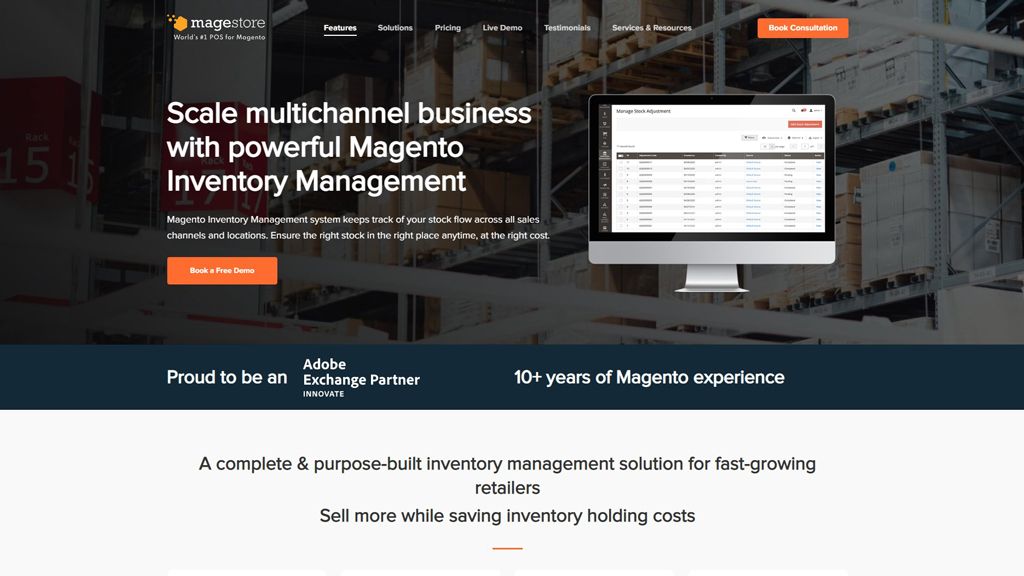
Magento Inventory Management by Magestore is a Point of Sale (POS) software with useful inventory management functionality. It streamlines multichannel retail for Magento merchants with stock taking, barcode management, and access control features.
Key Features:
- Real-time multichannel and location inventory sync.
- Inventory management with barcode scanning.
- Purchase Order support.
Pricing: Available on request.
Best Magento Inventory Management Tool for: Merchants that need inventory management with integration support.
2. SkuNexus

SkuNexus is an all-in-one system that ranges from real-time inventory to in-store fulfillment as well as multi-location management. It integrates directly with Magento, among 150 other ecommerce platforms and shipping carriers.
Key Features:
- Cross-channel order management automation.
- Custom workflows to automate fullfullment.
- Stock replenishment and inventory forecasting reports.
Pricing: Starts at $299/mo
Best Magento Inventory Management Tool for: Merchants who want fully customizable end-to-end order management.
3. Advanced Inventory by Wyomind
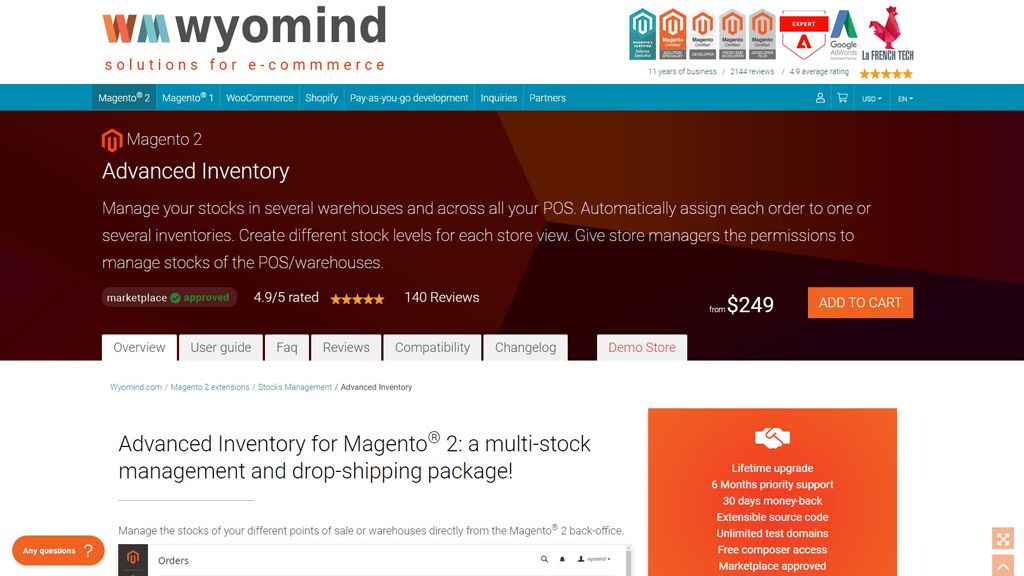
Advanced Inventory by Wyomind is an extension that enhances Magento’s default inventory management capabilities. It lets you configure manual and automatic dispatches, drop-ship management, and front-end display of different points of sale.
Key Features:
- Multichannel stock management options.
- POS and warehouse access control.
- Automated order assignment.
Pricing: $249 for Magento OS and $345 for Adobe Commerce.
Best Magento Inventory Management Tool for: Merchants that need drop shipping management functionality.
4. Multi Warehouse Inventory by Amasty
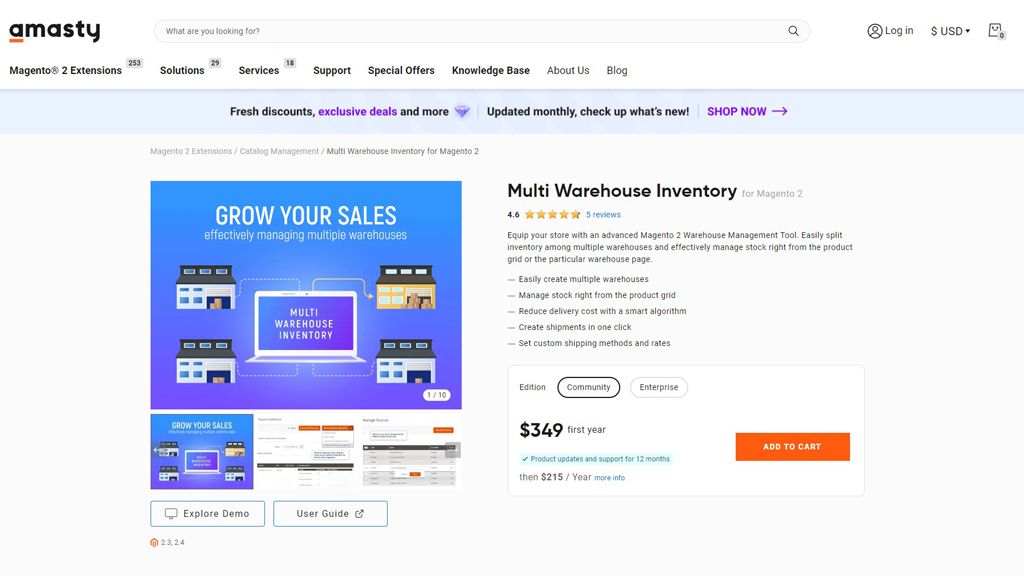
Multi Warehouse Inventory by Amasty is a Magento inventory management extension that simplifies managing inventory for a Magento store. It lets you assign inventory to warehouses, track stock levels across physical locations, and configure custom source selection algorithms.
Key Features:
- One-click shipment creation.
- Custom shipping methods and rates.
- Automatic source selection.
Pricing: Starts from $349 for the first year for Magento OS.
Best Magento Inventory Management Tool for: Merchants who want to customize Magento’s Source Selection Algorithm.
5. Multi Warehouse Inventory by Aitoc
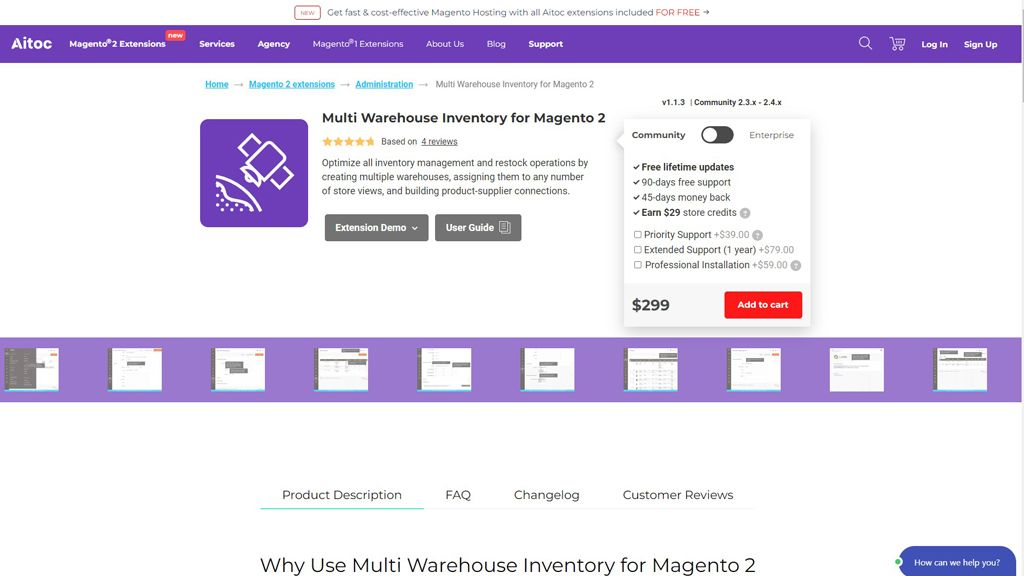
Multi Warehouse Inventory by Aitoc adds exclusive features to Magento 2 inventory management, such as multiple warehouse creation and assigning products to suppliers. It’s a simple yet useful Magento 2 extension that streamlines ordering from third-party suppliers.
Key Features:
- Unlimited warehouse management.
- Stock division by store view and customer groups.
- Automated warehouse selection and email notifications.
Pricing: $299 for Magento OS with lifetime free updates.
Best Magento Inventory Management Tool for: Merchants who need to automate inventory restocking.
6. Brightpearl by Sage
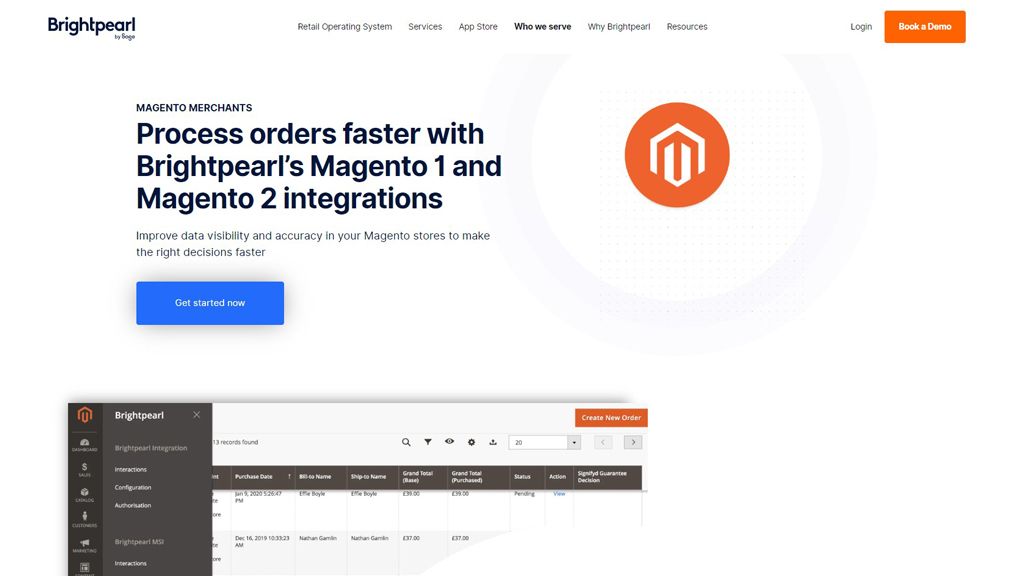
Brightpearl by Sage is an Enterprise Resource Planning (ERP) system that offers advanced inventory management features for Magento. It supports data-driven inventory planning and offers time-saving automation essential to speed up the reordering process.
Key Features:
- Real-time inventory reconciliation.
- Multichannel inventory management.
- Inventory analytics and excellent forecasting features.
Pricing: Available on request.
Best Magento Inventory Management Tool for: Merchants that need advanced inventory management features and comprehensive reporting functionality.
Final Thoughts: A Guide to Magento Inventory Management
Effective inventory management practices can help you reduce operating costs, predict future sales, and keep your ecommerce business profitable. More importantly, it ensures you don’t tie up your business capital in dead stock.
Data collected by Salsify reveals that 91% of U.S. shoppers worry about product availability and delays. A reliable Magento inventory management tool helps you overcome those issues and offer a stress-free customer experience by ensuring your products are always in stock.
But inventory is only one of the factors that impact the buying experience. You also need to ensure your Magento store is secure and loads fast.
Sign up for Managed Magento Hosting with Nexcess and access performance-optimized hosting built for scale. Why choose Nexcess?
Browse our plans to get started today.

